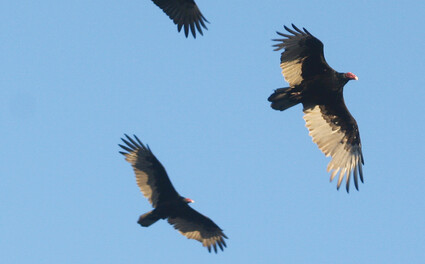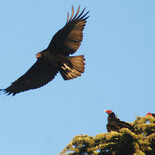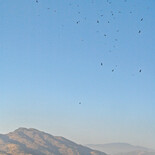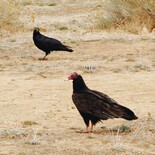Turkey Vultures passing through Tehachapi
Land of Four Seasons
October 14, 2023
If you've glanced up in the skies over Tehachapi in the past month or so, you might have seen lots of large dark birds circling. These are Turkey Vultures, and their annual migration is one of the great natural spectacles of California.
Each autumn, Turkey Vultures (Cathartes aura) come through Tehachapi Pass as they migrate south. There are not just hundreds, or even thousands of birds, but tens of thousands – a Turkey Vulture count in the fall of 2000 recorded 38,743 Turkey Vultures flying over the Tehachapi Valley during September and October.
Many of these migrants spend a night roosting in local trees, and Tehachapi newcomers are often startled to see trees festooned in the late afternoon by dozens of vultures, scattered among the branches like giant dark Christmas ornaments.
My brother even saw some of them on the ground at Jacobsen Middle School last week. This is a more unusual sighting, because during migration they typically soar all day, land in tall trees for the night, then launch back into the sky once the morning sun has warmed the Earth and started creating rising air currents.
The vultures were apparently on the ground at JMS because there was water present from irrigating lawns and landscaping. Vultures generally don't eat during migration, but they will drink when they get the chance.
The main reason for these big birds' migration is simple: they are following the sun. As winter approaches, the sun makes an apparent move to the south. Days get shorter, especially in the north, so Turkey Vultures have a difficult time finding the warm air thermals that they use to gain elevation and stay aloft in search of carrion.
So they simply follow the sun, heading south to Mexico and possibly further where the days are still reliably warm. After the Winter Solstice on December 21, the days begin to lengthen again. Vultures respond by starting to head back to the north again.
The first returning Turkey Vultures generally are spotted in the Tehachapi area as early as February, and throughout March and April more and more come through. Their northward migration is not as nearly as dramatic as their voyage to the south, however, and they seem to come back in a trickle rather than a flood.
The Nuwä (Kawaiisu or Southern Paiute) word for Turkey Vulture is wükümahaazi, pronounced wuh-kuh-mah-HAAH-zi, and Nuwä people were well aware of the annual Turkey Vulture flights.
Much of what we know about the Turkey Vulture migration through Tehachapi Pass comes from data gathered through the efforts of Clark and Jean Moore, a married pair of Tehachapi birders who organized vulture counts here 20 years ago. Clark, who passed away in 2007, and Jean had participated in vulture counts in the Weldon area of Kern County, near Walker Pass, and biologists there had urged them to start a count in the Tehachapi area, which they did.
The counts were conducted in September and October, from the top of Pauley Hill. This promontory is owned by the Rombouts family, and is located directly behind the Tehachapi Industrial Park and Home Depot. It offers a great view of the Tehachapi Valley and the skies overhead. Vulture-counting volunteers would stay on the hilltop in shifts all day long and count the big birds as they passed by.
The results surprised everyone. We knew many birds came through, but the totals were enormous: first 20,042 in 1999, and then with increased volunteer participation and counting days, a total of 38,743 in 2000 and 31,168 in 2001. Since we know that some birds were inevitably missed, it became clear that 30,000 to 40,000 Turkey Vultures migrate through Tehachapi Pass each fall, making our valley the scene of one of the largest Turkey Vulture migrations in the West. The hard work of the Moores and other Tehachapi Mountains Birding Club members made the collection of this data possible.
Most of the vultures that pass through Tehachapi each year have been here before, because Turkey Vultures live an average 10 to 15 years in the wild, and sometimes much longer. Vultures routinely live past 30 years in captivity, and may reach even more advanced age: a male Turkey Vulture named Lord Richard was hatched in captivity in 1974, and he is still living at the Lindsay Wildlife Experience in Walnut Creek, California and will be 50 years old on his next birthday.
Ornithologists believe that the migrants include birds from British Columbia, Washington, Oregon and Northern California. These vultures funnel down the Great Central Valley (the combined Sacramento and San Joaquin Valleys) with the Sierra Nevada forming a barrier to the east.
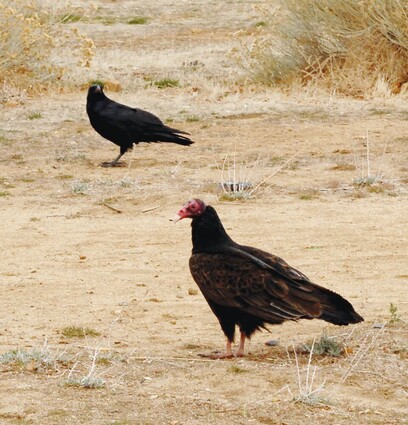
Jon Hammond.
A Turkey Vulture and a Common Raven on the ground in Golden Hills. This comparison reveals how the vultures are much larger.
When they reach the southern end of the Sierra, the birds cross over to the desert side of California, using Walker Pass and Tehachapi Pass as their main conduits. From there, they will continue south into Mexico, or Guatamala and further south.
And then, as early as February, the birds start heading back north in small groups. These incredible flyers with their kite-like soaring abilities are part of the seasonal rhythm of life here.
Keep enjoying the beauty of life in the Tehachapi Mountains.
Jon Hammond is a fourth generation Kern County resident who has photographed and written about the Tehachapi Mountains for 38 years. He lives on a farm his family started in 1921, and is a speaker of Nuwä, the Tehachapi Indian language. He can be reached at tehachapimtnlover@gmail.com.


